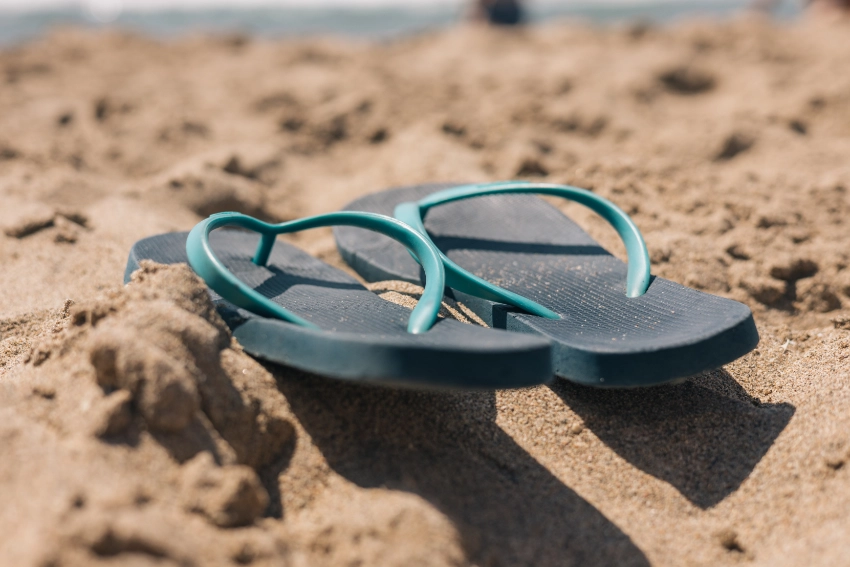
Living in beautiful Sarasota, FL, where the sun shines brightly and the beach beckons year-round, it’s no surprise that sandals and flip-flops are the footwear of choice for many residents. However, when it comes to the health of your feet, the differences between sandals and flip-flops are significant. At West Coast Podiatry Center, we’re committed to ensuring your feet—and by extension, your entire body—stay healthy and pain-free. In this guide, we’ll delve into why flip-flops might not be the best option and what alternatives can keep your feet happy.
Why Are Flip-Flops Bad?
Flip-flops might seem convenient and stylish, but they come with a host of issues that can negatively impact your foot health. Here’s a deeper look at the problems associated with flip-flops:
1. Lack of Support: Traditional flip-flops provide minimal to no arch support. This can lead to overpronation, where your foot rolls inward excessively, placing undue stress on the arches. Over time, this lack of support can result in conditions such as plantar fasciitis, which is the inflammation of the tissue along the bottom of your foot.
2. No Cushioning: Most flip-flops have a thin, flat sole that fails to cushion the impact of walking. This lack of shock absorption means that each step you take exerts more force on your heels and the balls of your feet, leading to pain and discomfort.
3. Unstable Design: The flimsy construction of flip-flops can make them unstable, increasing the risk of trips and falls. The lack of straps or proper fastening mechanisms means your foot can slip out easily, leading to injuries.
4. Altered Gait: Wearing flip-flops often forces you to grip the shoe with your toes to keep it on. This unnatural gait can lead to muscle strain and joint pain not just in your feet, but also in your ankles, knees, hips, and back.
Conditions Flip-Flops Can Cause
Here are some common foot conditions associated with prolonged flip-flop use:
- Plantar Fasciitis: This condition involves the inflammation of the plantar fascia, a thick band of tissue running across the bottom of your foot, connecting your heel bone to your toes. It causes stabbing pain, particularly in the morning.
- Achilles Tendinitis: Flip-flops lack the heel support needed to prevent strain on your Achilles tendon. Over time, this can lead to tendinitis, characterized by pain and stiffness in the back of your leg near the heel.
– Metatarsalgia: The absence of cushioning in flip-flops can lead to metatarsalgia, a condition marked by pain and inflammation in the ball of your foot. It’s often caused by excessive pressure on the metatarsal bones.
– Blisters and Calluses: The constant friction from flip-flop straps can cause blisters, while prolonged rubbing can lead to calluses—thickened, tough areas of skin that can be painful.
– Bunions and Hammertoes: The altered walking pattern caused by flip-flops can exacerbate or contribute to the development of bunions (bony bumps that form on the joint at the base of your big toe) and hammertoes (abnormal bends in the middle joint of your toe).
Alternatives to Flip-Flops
For the sake of your foot health, consider these alternatives to traditional flip-flops:
1. Supportive Sandals: Look for sandals with features like arch support, cushioning, and a sturdy sole. Brands like Birkenstock and Teva offer excellent options that provide the support your feet need without compromising on style.
2. Athletic Sandals: These sandals are designed for activity and often include supportive features similar to those found in running shoes, such as contoured footbeds and adjustable straps for a secure fit.
3. Orthopedic Sandals: Specifically designed for comfort and support, these sandals can be a great choice for those with existing foot issues. They often come with built-in orthotics and are crafted to alleviate foot pain and improve mobility.
If You Must Wear Flip-Flops
We understand that sometimes, flip-flops are just too convenient to pass up. If you must wear them, opt for styles that offer more support. Here are a few recommendations:
– Oofos: These flip-flops are designed with recovery in mind. They offer excellent arch support and cushioning to minimize the impact on your feet. The patented footbed cradles your arches, reducing stress on sore feet, knees, and back.
– Vionic: Known for their orthotic-grade arch support, Vionic flip-flops provide a good balance of style and support. They are designed to promote natural alignment from the ground up.
Choosing for Long-Term Health
In Sarasota, where casual, open footwear is a staple, it’s important to make choices that benefit your long-term health. Poor footwear choices can have far-reaching effects beyond just your feet—impacting your joints, posture, and overall well-being. Prioritizing supportive, well-constructed footwear can prevent a multitude of issues, allowing you to enjoy the sun, sand, and surf without pain or discomfort.
Conclusion
At West Coast Podiatry Center, we’re dedicated to helping you make the best choices for your foot health. While the allure of flip-flops is strong, especially in our sunny Sarasota climate, your feet—and the rest of your body—will thank you for opting for more supportive alternatives. Remember, the right footwear today can prevent a multitude of problems tomorrow. Stay smart, stay supported, and enjoy all that Sarasota has to offer with happy, healthy feet!

